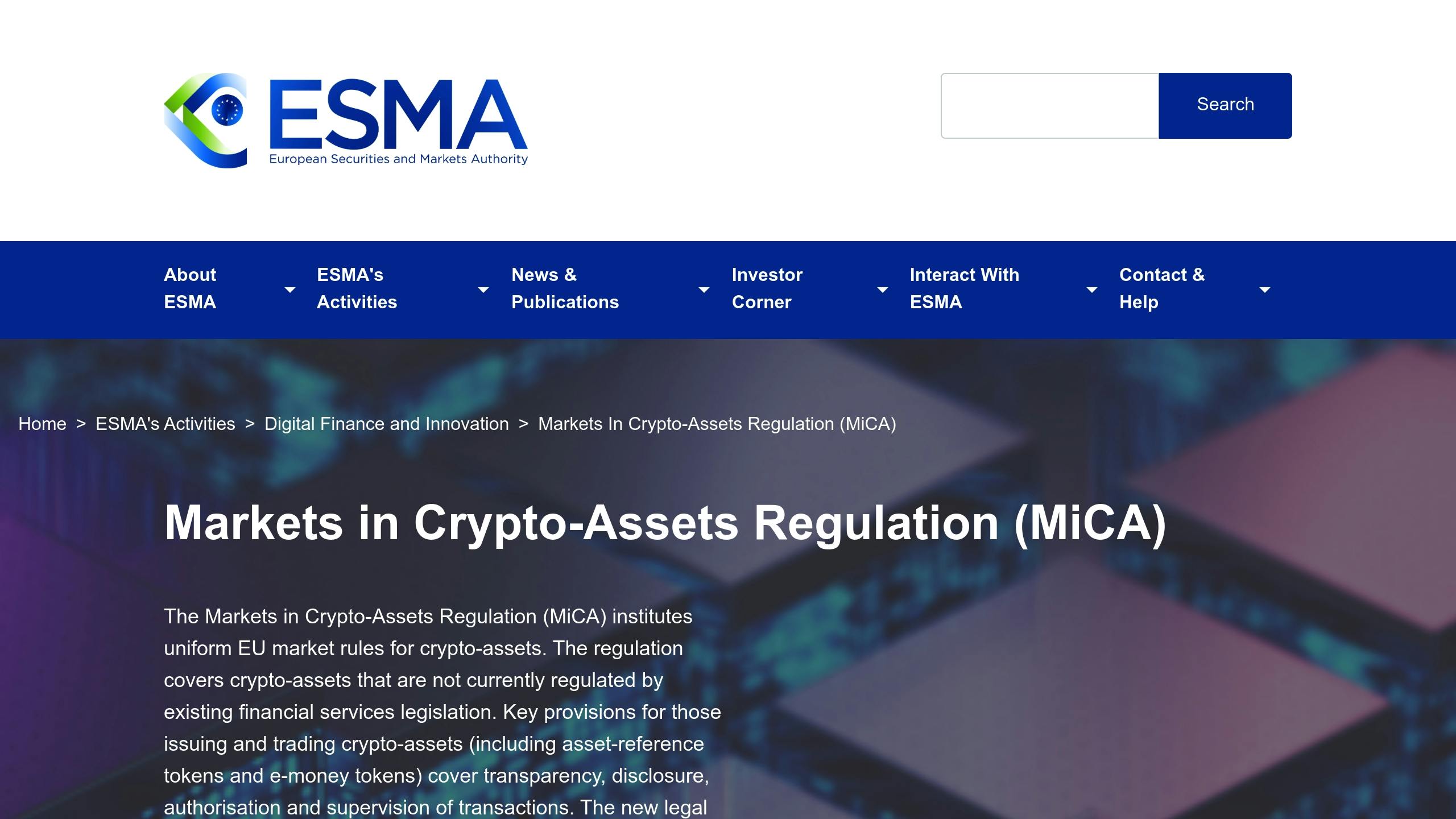Global crypto regulations are fragmented, creating challenges for businesses and investors. Countries have different rules, making compliance difficult for international companies and leaving gaps for bad actors. Efforts to align regulations are underway, with frameworks like the EU’s MiCA and FATF’s Travel Rule leading the charge. Key updates:
- EU MiCA Regulation: Aims to standardize rules across Europe by January 2025.
- FATF Travel Rule: Enforced in 65 jurisdictions, requiring transaction data sharing for amounts over $1,000.
- Regional Differences: U.S. treats most cryptocurrencies as securities, while Asia has mixed approaches.
- Challenges: Varying definitions, enforcement gaps, and technical hurdles persist.
Unified regulations could protect investors, streamline compliance, and support innovation. However, achieving global harmony remains complex.
| Region | Approach | Key Points |
|---|---|---|
| U.S. | Multi-agency oversight | SEC treats most crypto as securities; CFTC differs |
| EU | Unified framework (MiCA) | Clear rules for AML, market integrity by 2025 |
| Asia | Mixed approaches | Japan/Singapore progressive; China restricts crypto |
What’s next? MiCA enforcement starts December 2024, with global frameworks like CARF expected by 2027. Platforms must adapt by enhancing compliance systems, focusing on KYC/AML, and leveraging automated tools.
MiCA Regulations Explained: Legal Analysis and Implementation

Recent Changes in Global Crypto Rules
As the crypto market, valued at $2.24 trillion with $91 billion traded daily, grows, global regulators are pushing for standardized rules to address financial security and market stability concerns. Here’s a closer look at the organizations and measures shaping these changes.
Key Organizations Driving Regulation
The Financial Action Task Force (FATF) has taken the lead in creating consistent global standards. One of its main initiatives, the Travel Rule, mandates that Virtual Asset Service Providers (VASPs) share details about the originator and beneficiary for transactions over $1,000.
The Travel Rule’s adoption is gaining momentum worldwide:
| Implementation Status | Number of Jurisdictions |
|---|---|
| Legislation Passed | 65 jurisdictions (as of April 2024) |
| In Progress | 15 jurisdictions |
Focus Areas for Regulatory Alignment
Many jurisdictions, particularly in the European Union, are working to establish unified regulatory frameworks. The EU’s Markets in Crypto Assets (MiCA) regulation aims to create clear standards for anti–money laundering efforts, customer protections, market integrity, and cross-border transaction oversight.
While these frameworks are making headway, enforcement efforts reveal progress as well as hurdles.
Progress and Challenges in Enforcement
Recent enforcement actions underscore the impact of regulatory changes. For example, in May 2024, Binance was fined C$6 million by Canadian authorities for failing to meet anti–money laundering requirements.
The EU has also taken steps forward with the Transfer of Funds Regulation (TFR) 2023/1113, adopted on May 31, 2023, which applies the Travel Rule to VASPs.
However, achieving global harmonization isn’t without obstacles. Key challenges include:
| Challenge | Impact | Current Status |
|---|---|---|
| Technical Implementation | VASPs struggle with data-sharing infrastructure | Industry collaborations are developing solutions |
| Jurisdictional Differences | Compliance requirements vary across regions | Gradual alignment through FATF guidelines |
| Timeline Coordination | Different implementation deadlines create gaps | EU has set a December 2024 deadline for CASPs |
While progress is being made, balancing uniform implementation with operational efficiency remains a complex task.
sbb-itb-dd9e24a
Effects on International Trading Platforms
Meeting Multi-Country Requirements
Global platforms are under growing pressure to comply with a range of international trade regulations. In 2023, they face navigating 3,000 trade restrictions – a sharp increase from 2015’s numbers.
Here are some of the major hurdles they encounter:
| Challenge Area | Impact on Platforms | What’s Needed |
|---|---|---|
| Data Privacy | GDPR compliance for EU users | Region-specific data handling protocols |
| Asset Custody | Varying custody rules by region | Multi-jurisdiction custody solutions |
| Transaction Reporting | Different reporting thresholds/formats | Automated reporting systems |
| KYC/AML Standards | Market-specific verification needs | Scalable verification frameworks |
These challenges have pushed decentralized exchanges (DEXs) to develop creative compliance solutions.
DEX Platform Advantages
Decentralized exchanges have stepped up to address multi-country challenges, and their growth reflects it. From just 0.11% of global crypto trading in January 2019, DEXs now account for 14% as of August 2023, with monthly volumes surpassing $40 billion.
Platforms like Defx offer several regulatory benefits:
- Non-Custodial Setup: By not holding user assets, they sidestep custody-related complexities.
- Smart Contract Transparency: Transactions are settled on public blockchains, making them fully auditable.
- Automated Compliance: Protocol rules are built into the system, enforcing regulations programmatically.
New Global License Standards
Unified global licensing standards are reshaping how platforms operate, promoting regulatory consistency across borders. Financial institutions are increasingly turning to RegTech tools, transforming compliance from just a cost into a strategic asset.
These new frameworks focus on three key areas:
1. Cross-Border Compliance
Platforms are now using detailed documentation systems and automated compliance checks to navigate international regulations. A Cambridge University report notes the importance of a clear commercial justification for investing in compliance automation.
2. Risk Management
Platforms evaluate risks like geopolitical factors, currency fluctuations, regulatory changes, and cross-border settlements to stay ahead of potential challenges.
3. Technology Integration
Advanced tools such as real-time transaction monitoring, automated compliance checks, and integrated risk assessment systems are becoming standard in ensuring smooth operations.
What’s Next for Global Crypto Rules
Key Dates and Goals
Several important dates are on the horizon for global crypto regulations. MiCA enforcement is set to begin on December 30, 2024. Following this, DAC8 integration will be completed by December 31, 2025, with mandatory CASP reporting starting January 1, 2026. The CARF framework is expected to roll out by 2027. In Australia, a digital asset framework is being drafted for 2024, including a 12-month compliance transition period. Meanwhile, the United Arab Emirates has already established VARA, the world’s first dedicated crypto supervisory authority. These developments will play a big role in shaping market activity and user behavior.
Market and User Effects
Stablecoins are becoming a key focus, with over $190 billion in circulation and 80% of transactions happening across borders. In the U.S., regulators are working to balance blockchain innovation with the need to maintain dollar dominance, requiring stablecoins to operate within strict legal boundaries. In Europe, crypto is being treated more like traditional banking, as cryptocurrencies account for just 8% of digital payments. The Asia Pacific region offers a mix of approaches, ranging from Singapore’s supportive stance to China’s strict restrictions on crypto activities.
Unsolved Issues
Despite progress, several challenges remain unresolved. Fragmented regulatory responses could lead to operators seeking out jurisdictions with looser rules. Key issues include the lack of a universal definition for cryptocurrencies, risks tied to technology across crypto asset lifecycles, and limited capabilities for monitoring markets. Among 60 surveyed countries, cryptocurrency is fully legal in 33, partially banned in 17, and completely banned in 10, underscoring the enforcement difficulties in the digital age.
Conclusion: Next Steps
Main Points Summary
The global approach to crypto regulation is advancing, with notable milestones like MiCA’s enforcement set for December 30, 2024, and the SEC’s approval of Bitcoin Spot ETFs. However, challenges persist – only 33 out of 60 surveyed countries have fully legalized cryptocurrencies. Policies vary widely, such as India’s 30% tax on Virtual Digital Assets and South Korea’s planned 20% tax on gains over ₩50 million. Key issues include inconsistent terminology and limited regulatory oversight. Addressing these hurdles requires decisive action from industry players.
Steps for Industry Members
To tackle these challenges, the crypto industry must prioritize strong compliance practices. As global efforts to align crypto regulations progress, it’s crucial for both traditional institutions and decentralized platforms to strengthen their compliance measures. This includes implementing KYC, AML, and real-time transaction monitoring systems.
"For the industry to grow, flourish, and become the dominant mechanism of our global economy, we must deploy compliance layers into DeFi."
"The development of regulatory and legal frameworks in the past year have been instrumental in restoring trust in digital assets."
Regular risk assessments and access to legal expertise in digital assets are also essential. With over 90% of countries working on central bank digital currencies, staying informed and responsive to regulatory changes is critical for achieving long-term growth and stability.
